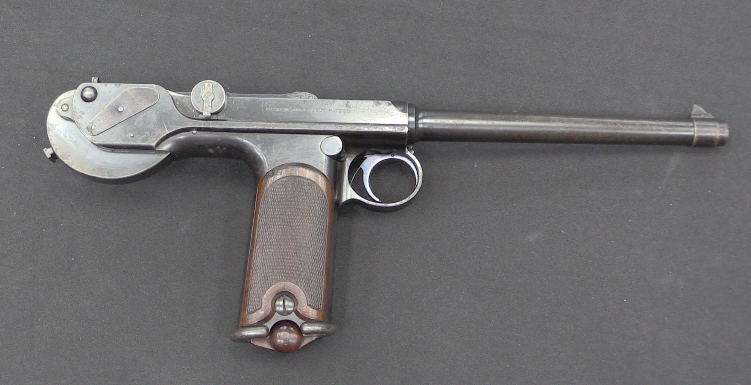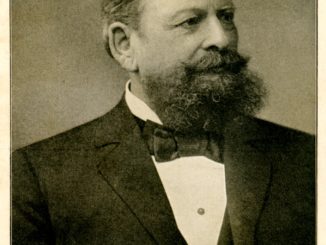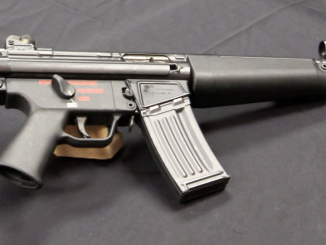Ferdinand von Mannlicher was a brilliant and prolific European gun designer with more than a few widely-adopted military arms to his name. One of his very last guns was this carbine, which was also one of the first intermediate cartridge carbines developed. It was a mostly experimental gun, and never saw large-scale production.
Mechanically, the gun is an evolution of his 1896/1901 automatic pistol and the 1901 carbine made from that pistol. It locks using a short recoil action and a tipping bolt, and was initially made in 7.63mm Mannlicher (dimensionally identical to 7.63mm Mauser but slightly less powerful). One of the shortcomings of the 1901 carbine was that the handguard was fixed to the recoiling barrel, so that a firm grip on the handguard would cause the gun to malfunction. The 1901/04 variant of the carbine fixed that issue by connecting the front handguard to the trigger frame, which did not move during cycling.
The most significant change of the 1901/04 design, however, was its size being scaled up to use a larger 7.63x32mm cartridge (sometimes misidentified as 7.63x45mm, as it’s overall length is 45mm). Ballistics for this cartidige appear to be lost, but the .30 Carbine (7.62×33) would appear to be very similar in size (although the Mannlicher case is slightly bottlenecked rather than straight). It retained the same 6-round magazine capacity as the earlier Mannlicher carbines, but a larger magazine could easily have been made. Development was ended because, alas, Mannlicher perished in 1904.




0:21 “quite possibly the coolest carbine every made.”
I’ll say!
Very interesting. Any evidence of influence between Ferdinand Mannlicher’s 7.65x32mm and the Winchester 1905 .32 SL cartridge for the blowback-operated M1905? I know the former cartridge was bottle-necked, the latter not. If so, then there might be a connection with the later U.S. .30 carbine/7.62x33mm cartridge, no?
My understanding of the Austro-Hungarian K.u.K. is limited to a handful of books, but it is mentioned in at least one that the AH thought it might be a good idea to equip the Stoßtruppen–like the German/Oskar von Hutier type–with only handguns, since the rifles and carbines were in short supply due to, well, AH industry. Apparently the idea was shot down (heh.) because there were similar, if not more severe, shortages of revolvers and pistols too… Let’s just say, in an alternate universe, that a carbine like that with, say, a ten round or fifteen round magazine, certain production short-cuts here and there, perhaps removing the rear sight entirely and just using an aperture in the bolt handle, etc. That well might have been a proto-assault rifle a la Ribeyrolle 8x35mm, no?
Awesome to see that a firearm designed in the early 20th century by Ferdinand von Mannlicher had a separate “upper” and lower receiver, ha!
“That well might have been a proto-assault rifle a la Ribeyrolle 8x35mm, no?”
There was cartridge, similar to later intermediate cartridges designed in Austria-Hungary in early 20th century – 8.2×45 Krnka:
http://www.municion.org/Krnka/8_2Krnka.htm
Notice that (at least dimensions wise) it is similar to .35 Remington.
8.2×45 Krnka was fired from Krnka automatic rifle, see photos:
http://milpas.cc/rifles/ZFiles/Semi-automatic%20Rifles/Krnka-Roth%20M.1899/Krnka-Roth%20M.1899.htm
On the basis of the ammunition being absolutely unobtainable commercially, that little carbine is potentially legal for private owners in the UK. so long as they don’t try to make ammunition for it.
Keith:
The Home Office have come up with a list of so-called obsolete ammunition which has no force in law and has been disregarded by courts. An antique is an antique by virtue of its age, not the availability of its ammunition (which would be illegal to own anyway without a certificate).
The courts have found that a .22LR rifle of 1906 is a legal antique, and there is no more common ammunition than that. That is surely the correct verdict, as the accepted rule of thumb for an object to be considered antique is that it is more than 100 years old. However I agree with you that this fascinating Mannlicher is certainly an antique, and I was surprised at the low estimate given for such a unique gun.
Manicher 1901 pistol had a very convenient feature to convert the construction into a carbine. Its breechbolt had been moving within the receiver without giving any outward extentions like an autoloading rifle. Therefore, the carbine version had a good opportunity of success. Its manually cocking, delocking hammer was also superb in safety department, but its overall construction was intriqued and costy.
Usually it’s hard to find a semiautomatic pistol whose operating system can be fitted to a pistol-caliber carbine. I had thought of drawing up a handgun similar to a Mauser C96 or a Bergmann Bayard that could also come in carbine form (sadly I had been inspired more by the Benelli MP90), but I have yet to reconcile the artwork with mechanical consistency (especially as I had depicted the muzzle of the barrel emerging from some sort of barrel sleeve, upon which the front sight is fixed).
Can anyone give me some ideas for drawing any revisions to the fictional pistol that won’t violate patents?
Patents have a life of 20 years from the date of filing. This means all patents to the date of 1995 are in public domain. However, trademarks based on outside forms survive
forever, like Gaston’s. If I were you, I would focus my work over a fixed barrel costruction getting use of the advantage of some unused spaces for mounting a good recoil absorber like VP70. No need to mention to replace the magazine from handlegrip to the front of the trigger guard.
“semiautomatic pistol whose operating system can be fitted to a pistol-caliber carbine”
F.V.Tokarev designed automatic-pistol-like-carbine (full-auto/semi-auto), see:
http://historypistols.ru/blog/pistolety-pod-unitarnyj-patron-avtomaticheskie/opytnye-obrazcy-pistoletov-tokareva/
(chapter 7,63-мм большой автоматический пистолет Токарева, опытный образец 1929 года which mean 7.63-mm big machine pistol, Tokarev, experimental, model 1929 year), data sheet:
cartridge – 7.63×25 Mauser, length – 465mm, mass – 2.265kg (loaded), magazine capacity – 22, wooden stock can be attached, sights scaled to 700m, fire selector on left side, principle of operation – short recoil.
This fire-arm never achieve enough reliability to be adopted.
“7.63x32mm cartridge”
Dimensions:
http://www.municion.org/7mm/7_65x32PistolenKarabiner.htm
If I understand this article data are from Fred A Datig book (“Cartridges for Collectors”?), this cartridge was manufactured by Hirtenberger (Hirtenberger Patronen, Zündhütchen und Metallwarenfabrik)
Yes, that is what it says about the cartridge examples pictured. Above, the claim is that the prototypes and the cartridges for the prototypes were constructed at SIG in Neuhausen in Switzerland.
It amazes me that with carbines like this, as well as others in mass production such as the Winchester 07 and Remington 08, that the “assault rifle” concept wasn’t developed during WW1. I guess tactical innovation couldn’t keep up with technical innovation.
I think you’ll find it was military conservatism, that couldn’t keep up with technical innovation. It’s pretty much the story of WW1.
If you look at the way some of the most effective units organized themselves – like trench raiders – you’ll see that the lightweight, semi-automatic or select fire carbine was far from unheard of. It usually took the form of a C96, or Luger, or Webley revolver, with a stock attached, rather than an actual carbine.
And in the later years of the war, something like the Pedersen Device is a clear signal that the U.S. at least, was taking what became the concept of the ‘assault rifle’, seriously. Imagine a more powerful Pedersen Device – perhaps in the power class of .30 Carbine, and introduced a year earlier – the Garand may never have seen the light of day.
The limiting factor though, remained the conservative military maxim that an infantryman’s rifle needed sufficient power to kill a cavalry horse at a thousand yards – which is pretty much the design principle that every service rifle cartridge developed 1880-1910 adhered to.
None of the ‘intermediate’ cartridges of the period – barring perhaps the 6.5x50SR Arisaka – had sufficient performance at range to be considered ‘general purpose’ in the parlance of the times, and those that came close did not have a suitable platform. The Winchester SL rounds are effectively a .357 Magnum analogue; others, comparable to a .30 Carbine.